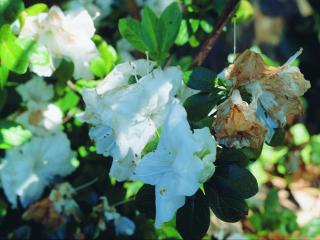Azalea petal blight
Symptoms of infection
Petal blight in azalea species and cultivars is caused by Ovulinia azaleae, a fungal disease. The first signs are small spots that look water-soaked. These enlarge rapidly and merge. Within two or three days, whole flowers become limp and slimy, and then turn light brown. The rotted flowers do not drop readily and, when they do, tend to adhere to the foliage where they can remain stuck for many weeks.
Life cycle of the fungus
Ovulinia azaleae over-winters in the form of sclerotia (hard-coated survival bodies) on the previous season’s diseased flowers, or in the surface soil and leaf litter beneath the plant. When the azalea is nearing its flowering time, the sclerotia germinate. Small, almost microscopic, cup-shaped fruiting bodies are produced, from which spores are discharged.
Moist conditions allow the disease to develop. Periods of frequent rainfall or misty weather that coincide with flowering time will accelerate the rate of infection. Overhead watering has the same effect.
Control
To begin the new season well, pick off any diseased flowers that have hung on from the previous year and remove leaf litter from beneath infected plants.
By the time spots appear on the petals of the new season’s flowers, it is usually too late to combat the disease with fungicide. However, fungicide can be used as a protector if applied just before bud opening. The best time to spray is when the green buds begin to show their flower colour.
Apply a systemic fungicide with tebuconazole and trifloxystrobin every 14 days until the end of flowering or mancozeb with sulphur every 10 days until flowering finishes.
Unfamiliar pests
The Department of Agriculture and Food, Western Australia (DAFWA) is on the lookout for animal and plant pests, diseases and weeds that could pose a threat to agriculture and the environment.
If you discover something unfamiliar please send a photo to the Pest and Disease Information Service (PaDIS) by email: info@agric.wa.gov.au or phone them on Freecall: 1800 084 881.
Please read the sending specimens for identification web article before sending samples to the Pest and Disease Information Service, 3 Baron-Hay Court, South Perth, 6151, WA.

